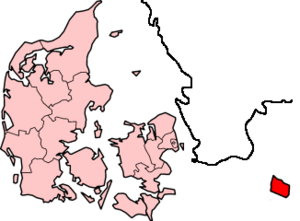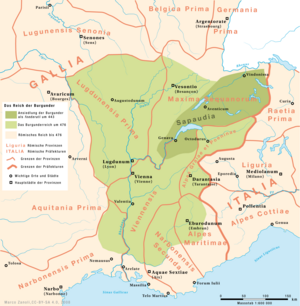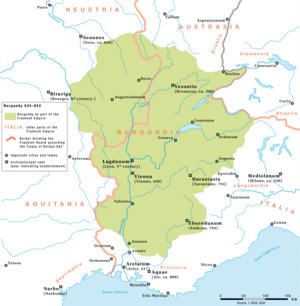Burgundians facts for kids

The Burgundians were an early Germanic tribe. They first appeared near the Roman Empire in the middle Rhine region. Later, they moved into the Roman Empire, settling in eastern Gaul. Some records suggest they lived even earlier in a part of Germania, which is now Poland.
The Burgundians are first mentioned around 291 AD, alongside the Alamanni. They lived as neighbors for many centuries. By 411 AD, a group of Burgundians had settled on the Rhine River. They controlled cities like Worms, Speyer, and Strasbourg. In 436 AD, the Roman general Aëtius defeated them with the help of Hunnish forces. Then, in 443 AD, Aëtius moved the Burgundians to eastern Gaul, inside the Roman Empire.
This area in Gaul became known as the Kingdom of the Burgundians. Later, it became part of the Frankish Empire. The name of this old kingdom lives on today in the region called Burgundy in modern France. This region is only a small part of the original kingdom. Another group of Burgundians joined Attila's Hunnic army by 451 AD.
Before clear records began, the Burgundians might have moved from the Baltic island of Bornholm. They may have traveled to the Vistula River area in what is now Poland.
Contents
Who Were the Burgundians?
The name "Burgundians" usually refers to the people who settled in eastern Gaul and the western Alps around 400 AD. Their original kingdom did not cover the same area as modern Burgundy in France. Instead, it was closer to areas like Franche-Comté and Rhône-Alpes in France. It also included Romandy in Switzerland and Aosta Valley in Italy.
Today, "Burgundians" can sometimes mean people from the modern French region of Burgundy. This region got its name from the old kingdom. However, the borders of "Burgundy" have changed many times over the centuries. In the Middle Ages, the term "Burgundian" could also refer to the powerful people controlled by the Dukes of Burgundy. Their lands included parts of modern Belgium and the Southern Netherlands.
Early History of the Burgundians

Historians have different ideas about where the Burgundians came from. Some older theories suggested they came from Scandinavia. This idea was based on old place names and archaeological finds. Many believed they originally lived on the Baltic island of Bornholm, which means "the island of the Burgundians" in Old Norse. Around 250 AD, many people left Bornholm.
Ancient Roman writers like Tacitus and Pliny the Elder knew little about Germanic peoples east of the Elbe River. However, Pliny mentioned a group similar to the Burgundians among the Vandalic peoples. He said they lived between the Oder and Vistula rivers. Around the mid-2nd century AD, many Germanic tribes moved southeast. This caused problems along the Roman border.
In the late 200s AD, the Burgundians appeared on the east bank of the Rhine River. They seemed to be facing Roman Gaul. The Roman emperor Probus defeated them in 278 AD. A few years later, they were mentioned alongside the Alamanni. These groups moved into an area east of the Rhine, sometimes attacking Roman Gaul.
In 369/370 AD, Emperor Valentinian I asked the Burgundians for help in his war against the Alamanni. About 40 years later, the Burgundians appeared again. After Roman troops were pulled back to fight the Visigoths, many groups from central Europe moved west. Some Burgundians also moved west. They settled as allies (called foederati) in a Roman province along the Middle Rhine. Other Burgundians stayed outside the empire and joined Attila's army by 451 AD.
The Burgundian Kingdom
The Rhineland Kingdom
In 411 AD, the Burgundian king Gundahar worked with Goar, king of the Alans, to set up a puppet emperor named Jovinus. With this emperor's permission, Gundahar settled his people on the Roman side of the Rhine River. They took control of Worms, Speyer, and Strassburg. Later, the Roman Emperor Honorius officially gave them this land. Their capital was at Worms.
Even though they were Roman allies, the Burgundians raided Roman lands. This became a big problem. In 436 AD, the Roman general Aëtius called in Hun mercenaries. They attacked the Burgundian kingdom in 437 AD. King Gundahar was killed, and most of the Burgundian tribe reportedly died too.
The destruction of Worms and the Burgundian kingdom by the Huns became famous in heroic legends. These stories were later included in the Nibelungenlied. This epic poem inspired Wagner's famous opera series, the Ring Cycle. In these tales, King Gunther and Queen Brünhild have their court at Worms.
Settling in Eastern Gaul
For reasons not fully known, the Burgundians were again granted ally status. In 443 AD, Aëtius resettled them in Sapaudia. This area was part of the Gallo-Roman province of Maxima Sequanorum. Burgundians likely lived near Lugdunum, which is now Lyon. A new king, Gundioc (thought to be Gundahar's son), began to rule. He made Vienne the capital of the Burgundian kingdom. Eight Burgundian kings from Gundahar's family ruled until the Franks took over the kingdom in 534 AD.
As allies of Rome, the Burgundians fought alongside Aëtius and the Visigoths against Attila at the Battle of Châlons in 451 AD. The Burgundians and Visigoths seemed to be strong allies. Gundioc and his brother Chilperic I even went with Theodoric II to Spain to fight the Sueves in 455 AD.
Growing Influence
In 455 AD, a Burgundian leader was linked to the murder of Emperor Petronius Maximus. This happened during the chaos before the Vandals sacked Rome. This event shows the first connection between the Burgundians and the powerful Roman general Ricimer. Ricimer was probably Gundioc's brother-in-law.
In 456 AD, the Burgundians felt their power growing. They made a deal to expand their territory and share power with Roman senators. In 457 AD, Ricimer overthrew another emperor, Avitus. He then put Majorian on the throne. However, Majorian was not helpful to Ricimer or the Burgundians. He took back lands the Burgundians had gained. After showing more independence, Ricimer had him killed in 461 AD.
Ten years later, in 472 AD, Ricimer was plotting with Gundobad to kill his own father-in-law, Emperor Anthemius. Gundobad reportedly killed the emperor himself. Ricimer then appointed Olybrius as emperor. Both Ricimer and Olybrius died of natural causes within a few months. Gundobad then became a powerful king-maker, putting Glycerius on the throne.
By 474 AD, Burgundian influence over the empire seemed to end. Glycerius was removed from power. Gundobad returned to Burgundy, likely after his father Gundioc died. Around this time, the Burgundian kingdom was divided among Gundobad and his brothers: Godigisel, Chilperic II, and Gundomar I.
Uniting the Kingdom
According to the historian Gregory of Tours, Gundobad's return to Burgundy led to a bloody struggle for power. Gregory says that Gundobad killed his brother Chilperic. He also drowned Chilperic's wife and sent their daughters away. One of these daughters, Clotilda, later married Clovis, the king of the Franks. She is believed to have helped convert him to Christianity.
Around 500 AD, Gundobad and Clovis were at war. Gundobad's brother Godegisel betrayed him and joined the Franks. Together, Godegisel's and Clovis's armies "crushed the army of Gundobad." Gundobad hid in Avignon for a time. But he was able to gather his army again and attacked Vienne. There, Godegisel and many of his followers were killed. From this point on, Gundobad seemed to be the only king of Burgundy. This suggests his brother Gundomar had already died.
Gundobad and Clovis either made peace, or Clovis's earlier victory forced Gundobad to become his ally. The Burgundian king helped the Franks in 507 AD. They won a victory over Alaric II the Visigoth.
During this time, between 483 and 501 AD, Gundobad started writing the Lex Gundobada (Burgundian Law). He wrote the first part, which was similar to the Visigothic law. After he united his power, between 501 AD and his death in 516 AD, Gundobad wrote the second part of his law. This part was more uniquely Burgundian.
The Fall of the Kingdom
The Burgundians were expanding their power across eastern Gaul. This included parts of western Switzerland, eastern France, and northern Italy. In 493 AD, Clovis, king of the Franks, married the Burgundian princess Clotilda. She was the daughter of Chilperic. Clotilda helped convert Clovis to the Catholic faith.
At first, the Burgundians were allies with Clovis' Franks against the Visigoths in the early 500s. However, the Franks eventually conquered the Burgundians at the Battle of Autun in 532 AD. The Burgundian kingdom then became part of the Merovingian Frankish kingdoms. The Burgundian people were mostly absorbed into the Frankish society.
Burgundian Language and Religion
Quick facts for kids Burgundian |
|
|---|---|
| Region | Germania |
| Extinct | 6th century |
| Language family |
Indo-European
|
| Linguist List | qlb |
The Burgundians and their language were described as Germanic. Their language is thought to have been part of the East Germanic language group. This is based on ideas that they were the same Burgundians mentioned earlier in the east. However, this is not certain. We know very little about their language. Some Burgundian names are recorded. A few words used in the area today might come from the old Burgundian language. But it is hard to tell them apart from other Germanic words.
The Burgundian language likely died out in the late 500s AD. This was probably because the Burgundians quickly converted to Latin Christianity.
Before moving west, the Burgundians had converted to Arian Christianity from their earlier Germanic paganism. Arianism was a different form of Christianity than what the Catholic Western Roman Empire followed. This caused some suspicion and distrust.
However, these differences seemed to heal around 500 AD. Gundobad, one of the last Burgundian kings, was good friends with Avitus, the bishop of Vienne. Also, Gundobad's son and successor, Sigismund, was a Catholic himself. There is also evidence that many Burgundian people had converted to Catholicism by this time.
Burgundian Law
The Burgundians created three important legal codes. These are some of the earliest laws from any Germanic tribe.
The Liber Constitutionum sive Lex Gundobada ("The Book of Constitutions or Law of Gundobad"), also known as the Lex Burgundionum, was written in several parts between 483 and 516 AD. It was mainly written by Gundobad, but also by his son, Sigismund. This law code recorded Burgundian customs and laws. It is similar to other Germanic law codes from that time. This law book is one of the main sources for understanding Burgundian life and the history of their kings.
Like many Germanic tribes, the Burgundians' laws allowed different rules for different groups of people. So, in addition to the Lex Gundobada for Burgundians, Gundobad also created laws for the Roman people living in the Burgundian kingdom. This was called the Lex Romana Burgundionum ("The Roman Law of the Burgundians").
Gundobad's son Sigismund later published another law called the Prima Constitutio.
See also
 In Spanish: Pueblo burgundio para niños
In Spanish: Pueblo burgundio para niños
- Dauphiné
- Duchy of Burgundy
- Franche-Comté
- List of ancient Germanic peoples and tribes
- List of kings of Burgundy
- Nibelung (later legends of the Burgundian kings)




